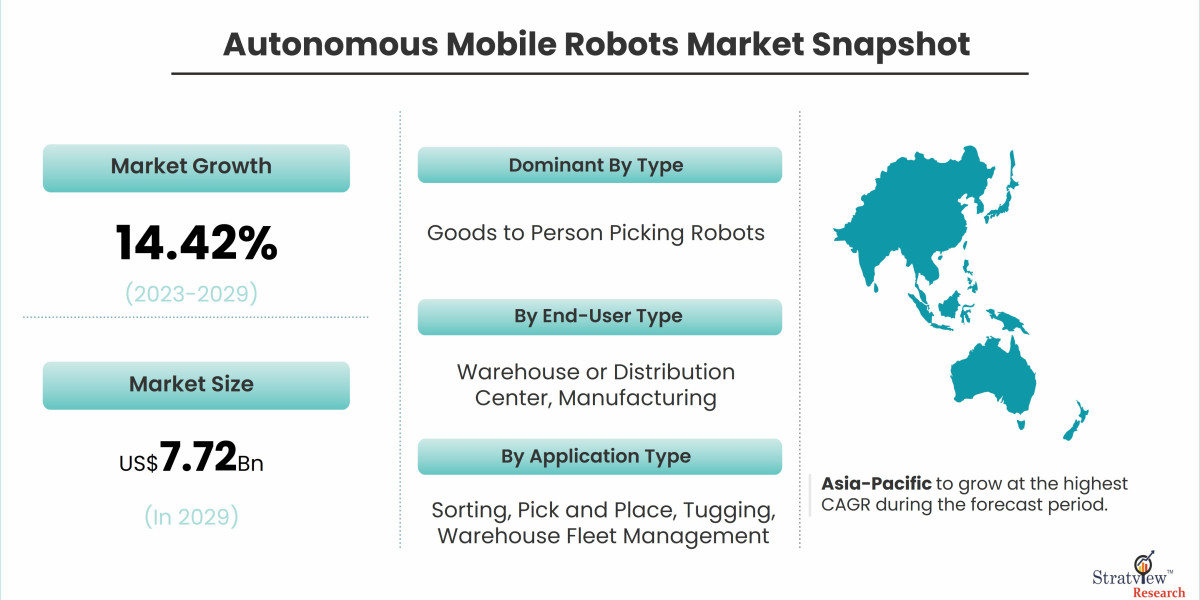The autonomous mobile robots (AMRs) market is experiencing explosive growth, driven by the increasing demand for automation across industries such as logistics, manufacturing, healthcare, and retail. These intelligent, self-navigating robots offer significant opportunities for enhancing operational efficiency, reducing costs, and optimizing workflows. However, despite the market’s promising potential, it also faces several challenges that businesses must navigate to capitalize on the opportunities presented.
According to Stratview Research, the autonomous mobile robots market was estimated at USD 2.98 billion in 2022 and is likely to grow at a CAGR of 14.42% during 2023-2029 to reach USD 7.72 billion in 2029.
Opportunities in the Autonomous Mobile Robots Market
One of the most compelling opportunities in the autonomous mobile robots market is the ability to streamline logistics and warehousing operations. As e-commerce continues to boom, the pressure to optimize supply chain processes has intensified. Autonomous mobile robots can efficiently handle tasks like sorting, picking, and transporting goods within warehouses, freeing up human workers to focus on more complex tasks. This results in faster delivery times, reduced labor costs, and improved accuracy in inventory management.
Moreover, the flexibility of autonomous mobile robots makes them a game-changer for businesses of all sizes. Unlike traditional automated guided vehicles (AGVs), which require fixed infrastructure, autonomous mobile robots can navigate dynamically through environments using sensors and AI algorithms. This adaptability means that companies can deploy AMRs without significant investments in infrastructure, making it easier for small and medium-sized enterprises (SMEs) to adopt automation.
Beyond logistics, industries like healthcare and manufacturing are also benefiting from autonomous mobile robots. In hospitals, autonomous mobile robots are used to transport medical supplies, medications, and equipment, alleviating the burden on healthcare workers. In manufacturing, autonomous mobile robots help improve production efficiency by delivering materials to assembly lines, minimizing downtime, and enhancing workflow.
Challenges in the Autonomous Mobile Robots Market
Despite the promising outlook, the autonomous mobile robots market faces several challenges that could hinder its growth. One of the primary obstacles is the high upfront cost of adopting AMRs. While the long-term benefits of reduced labor costs and improved efficiency are clear, the initial investment can be prohibitive for some businesses, particularly SMEs. As a result, companies need to carefully weigh the potential return on investment (ROI) when considering the deployment of autonomous mobile robots.
Another challenge is the complexity of integration. autonomous mobile robots need to be seamlessly integrated into existing workflows and systems to achieve maximum efficiency. This often requires significant planning and customization, which can be time-consuming and expensive. Companies must ensure that their IT infrastructure can support the deployment of these robots and that employees are adequately trained to work alongside them.
Security is also a growing concern, particularly as autonomous mobile robots become more connected through the Internet of Things (IoT). Cybersecurity risks, such as data breaches and unauthorized access to robotic systems, need to be addressed to ensure the safe and reliable operation of autonomous mobile robots.
The Road Ahead
Despite the challenges, the autonomous mobile robots market is set to continue growing as technological advancements make robots more capable and affordable. Opportunities abound for companies that are willing to invest in innovation and overcome the barriers to adoption. By carefully navigating these challenges, businesses can unlock the full potential of autonomous mobile robots, driving greater efficiency and competitiveness in an increasingly automated world.
In conclusion, the autonomous mobile robots market offers exciting opportunities, but businesses must be mindful of the challenges that come with implementing these advanced technologies. With the right strategy and investment, companies can successfully navigate the market and position themselves at the forefront of the automation revolution.



